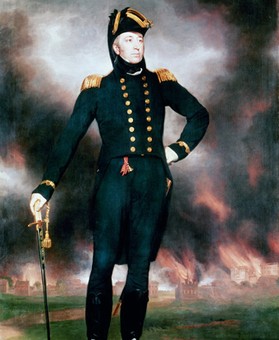British Invasion of Ocracoke Historical Marker
Introduction
Text-to-speech Audio
Images
"British Invasion," Historical Marker Database

Admiral George Cockburn

Backstory and Context
Text-to-speech Audio
In February 1813, the British Royal Navy arrived in the Chesapeake Bay. With war erupting against the United States the year prior, the British hoped to blockade the Chesapeake, bottling up American shipping and shutting down two major ports in Baltimore and Norfolk. The British blockade proved successful; so successful in fact that American merchants, unable to leave Norfolk harbor, began shipping their goods down to the North Carolina coast. Dotted with countless islands and inlets, the Carolina coast offered American privateers a perfect refuge from the British blockade. Ocracoke and Portsmouth in particular became hubs for blockade runners.
The British determined to strike at Ocracoke and Portsmouth and shut down American privateering along the upper Carolina coast. In the dark evening of July 11-12, 1813, Rear Admiral George Cockburn sailed into Ocracoke Inlet; Ocracoke Island lay to the east, and Portsmouth Island just to the west. Cockburn’s force consisted of the 74-gun ship of the line Sceptre, the brig Conflict, and a number of troopships and tenders. Aboard the ships were nearly 800 Royal Marines and regular infantry.
The inlet sheltered three American ships: the Anaconda, the Atlas, and the revenue cutter Mercury. Although the Mercury managed to slip away upon the British approach, the skeleton crews of the Anaconda and Atlas prepared to defend their ships. British boarding parties launched in small boats and slowly made their way through the rough waters of the inlet in the darkness. One British officer complained, “In landing at Ocracoke we nearly all drowned.”[1]
As the British approached the harbor, the American ships opened fire. With too few crew and firing into the darkness, the Americans proved unable repulse the British advance. As the British neared, the crews abandoned ships. The crew of the Atlas even fired a cannon into the ship’s bottom in hopes of sinking her. The British, however, managed to secure and salvage both ships; they served with the British fleet through the remainder of the Chesapeake Campaign.
Having overcome the paltry American resistance, the British landed on Ocracoke Island. Accounts of what happened next conflict. Admiral Cockburn reported that he confiscated and paid for local livestock and stripped the town of military stores. Americans, however, claimed the British thoroughly sacked the island. “There was the most wanton, cruel and savage like destruction of property I have ever witnessed,” according to one American official.[1] The British occupied the island for until July 16 before setting sail back to the Chesapeake Bay.
Ultimately, the British incursion into Carolina achieved relatively little. Although the British captured two new ships, without permanently stationing themselves off the Carolina coast there was little to prevent the Americans from continue to use Ocracoke and Portsmouth as a viable trading alternative to Norfolk. Although the British expedition caused considerable panic in North Carolina, the British never returned, and Americans continued to use the Carolina coast for shipping until war’s end.
A state historical marker on the North Carolina mainland denotes the 1813 British incursion into the Carolina coast.
Sources
1. Stanley L. Quick and Chipp Reid. Lion in the Bay: The British Invasion of the Chesapeake, 1813-1814. Annapolis, MD: Naval Institute Press, 2015.
2. David A. Norris. "War of 1812." 2006. NCPedia. Web. Accessed December 28, 2020. https://www.ncpedia.org/war-1812
3. "British Invasion." North Carolina Highway Historical Marker Program. Web. Accessed December 28, 2020. http://www.ncmarkers.com/Markers.aspx?MarkerId=B-19
https://www.hmdb.org/m.asp?m=57001
National Park Service: https://www.nps.gov/people/george-cockburn.htm
